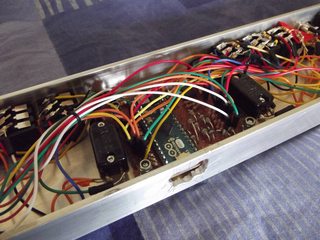Grit
Member
Well I've been working on this little gizmo for the past few weeks, finished it today and thought some of you guys might enjoy a look...
I wasn't quite satisfied with the FCB1010, because the expression pedals were flimsy, the buttons were chunky and too close together, and I needed some more external switch inputs in order to give my co-guitarist some controls for his own effects (in my band we put both guitarists through the Axe). Could have bought an MFC, but personally I think it's a bit too big for what I need, and also fairly expensive... total cost for this (not including time spent building it) was not far off £100.
At risk of sounding like a salesman, easiest way of giving a quick overview seems to be to list the features:
Current Features
Future Features
Believe it or not the hardest part of this was soldering the damn thing up! Case is made from 3inch by 1inch aluminium C section (1/8inch thick), which I milled/drilled at my old school's Design+Tech department (many thanks to them). Arduino programming was actually fairly straightforward, with the trickiest bit being getting the optoisolator (used to isolate the MIDI-in jack) to work because I kept wiring it up wrong on the breadboard. Total code is currently slightly over 800 lines, including comments, so really it's very manageable.
All in all, lots of fun building this little gadget - I'm very confident in its reliability and it'll be going with me next time I'm on stage! Would encourage you all to have a tinker with this sort of thing; I'd imagine the extra expression pedal/switch inputs alone could make one of these very useful to a large number of you
Pics of course - the LEDs are so bright that they actually threw the camera off focus on a few shots, but I think there's enough there for people to make things out. Schematic + code snippets etc will be available upon request






I wasn't quite satisfied with the FCB1010, because the expression pedals were flimsy, the buttons were chunky and too close together, and I needed some more external switch inputs in order to give my co-guitarist some controls for his own effects (in my band we put both guitarists through the Axe). Could have bought an MFC, but personally I think it's a bit too big for what I need, and also fairly expensive... total cost for this (not including time spent building it) was not far off £100.
At risk of sounding like a salesman, easiest way of giving a quick overview seems to be to list the features:
Current Features
- Six heavy duty, silent footswitch buttons
- Sends PC and CC messages - top LEDs (red) display current preset; lower LEDs (blue) display stomp-box style fx states (I don't use scenes due to having two different people pressing buttons)
- Receives Tuner Sysex to show on red LEDs while tuning (so you don't have to look at the Axe's screen)
- Three expression pedal inputs (with individual calibration)
- Two external switch inputs - can use two mono jacks or one stereo jack. Dedicated, hardwired LEDs show the status of the external switches on the main board
- CC channels for the expression pedals can be changed using the buttons - something also possible on the FCB but otherwise quite unusual, I think
- Rock-solid aluminium casing
- Reprogramamble Arduino Micro functions as the "brain"
- Can switch between different modes of operation (seeing as it'll do whatever the code tells it to do)
- Battery Powered
- Tool-less dis-assembly for reprogramming or battery change
- Easily fits inside a rack case for transport with the Axe
- Protection circuitry shields the Arduino from any static shocks etc that might come in through the inputs (...hopefully)
Future Features
- Need to figure out the best way to neatly label all the inputs, outputs and switches
- Could be very easily programmed to use scenes, or send Sysex messages to the Axe (to control things like amp bass/mid/treble etc that can't be controlled with CC messages)
- Include ability to power the unit through the midi cable (the midi jacks are 7-pin so I would just need to solder up a few diodes to make an "intelligent switcher" to choose between battery or cable power)
Believe it or not the hardest part of this was soldering the damn thing up! Case is made from 3inch by 1inch aluminium C section (1/8inch thick), which I milled/drilled at my old school's Design+Tech department (many thanks to them). Arduino programming was actually fairly straightforward, with the trickiest bit being getting the optoisolator (used to isolate the MIDI-in jack) to work because I kept wiring it up wrong on the breadboard. Total code is currently slightly over 800 lines, including comments, so really it's very manageable.
All in all, lots of fun building this little gadget - I'm very confident in its reliability and it'll be going with me next time I'm on stage! Would encourage you all to have a tinker with this sort of thing; I'd imagine the extra expression pedal/switch inputs alone could make one of these very useful to a large number of you
Pics of course - the LEDs are so bright that they actually threw the camera off focus on a few shots, but I think there's enough there for people to make things out. Schematic + code snippets etc will be available upon request







